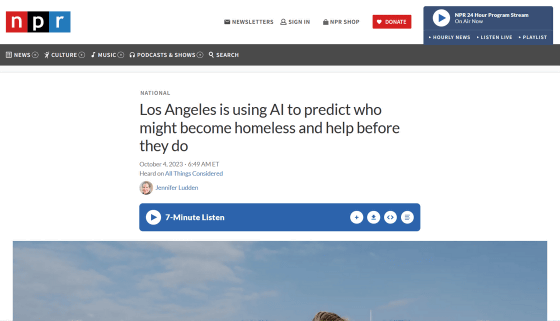An initiative is underway in Los Angeles to use AI to detect potential homeless people and provide them with support.

In the United States, where there is a huge disparity between rich and poor, an increasing number of people are becoming homeless because they are unable to pay rent due to soaring prices of goods and land. Meanwhile, an initiative is underway in Los Angeles County, California to use AI to detect potential homeless people and provide them with support.
Can AI predict, and try to prevent, homelessness? : NPR

One day, Dulce Volantin, who lives in Los Angeles, received a call from a stranger offering financial help. At the time, Mr. Volantin was living with his partner Valarie Zayas, but he lost the car he had been using for sleeping in the car and had to sell blood and clothes to earn money for accommodation. Mr. Volantin suffers from severe mental illness, and Mr. Zayas is also looking for temporary employment, so he was initially suspicious of the phone call in a situation near his limit.
However, when Volantine decided to call back, it turned out that the call was indeed an official call from the Los Angeles County Department of Health Services. After months of discussions with a case manager, the Volantines were able to move into a subsidized apartment that would accommodate their mental health needs.
Zayas also said that as a result of getting stable housing, he was able to get a good job at a transportation company. Zayas says, 'I feel refreshed. I don't have to worry about what I'm going to eat next.'

Volantine and his colleagues were reached out as part of a pilot program run by the Department of Health Services' Homeless Prevention Division. The pilot program uses AI to analyze data collected from county agencies, such as emergency room visits, mental health issues, substance abuse diagnoses, arrests, and enrollment in public benefits programs such as food assistance, to identify individuals experiencing homelessness. The idea is to identify such people and call them out.
Despite spending a large amount of money on building low-income housing to combat the increasing number of homeless people in Los Angeles County, dozens of new homeless people are emerging every day. 'It's a hole in the bucket and we have to do something about it,' said Dana Vanderford, who is leading the pilot program. ``There is a very low possibility that they will become homeless,'' he said, arguing that it would be effective for the government to identify potential homeless people.
In this program, case managers will work with the recipients for four to six months to consider how to use the allocated aid money, which totals $4,000 to $6,000 (approximately 600,000 to 900,000 yen). Many people need assistance with rent, but the underlying problem is often elsewhere, and they may recommend repaying loans, purchasing electrical appliances, or purchasing laptops. In one case, the company covered the cost of purchasing an electric bicycle for a person who was unable to use public transportation due to mental illness.
Case manager Elizabeth Juarez says, 'We talk to them about, 'What are your living conditions like? Maybe you're indoors, but is it safe? Do you have a bed? You're growing up. Do we have what we need to feel stable?'' He emphasized the importance of providing support tailored to people's needs.

The Los Angeles pilot program was conducted over two years and reached 560 people. Data show that the vast majority have been able to secure housing so far, but to accurately measure effectiveness, a randomized controlled trial will include follow-up of people with similar needs but who did not receive assistance from the program. is planned. The program's funding is expected to run out in 2026, and if research published around this time confirms the program's successes, further funding and scope will be provided.
Related Posts:
in Note, Posted by log1h_ik







